19 garden landscaping ideas for your dream outdoor space
Create a new garden from scratch or develop an existing space with help from our landscape design experts
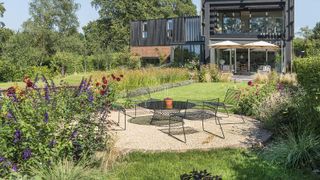
Lacking garden landscaping ideas for your plot? Whether you have self-built and are staring at your bare plot trying to summon some garden inspiration, or have inherited a less-than-attractive outdoor space, these inspiring ideas will help kickstart your landscape journey.
You should approach garden design just as you would the design of a house, something that will cater to your own taste and individual requirements.
Our round-up of garden landscaping ideas brings together some of the best tips around on how to get stuck into transforming your new outdoor space from bland to grand.
Get the most from your plot with these garden landscaping ideas
Before you can start to develop your landscaping ideas you need to pull together a list of your top garden priorities. For your redesigned garden to meet all of your needs, you need to know what you want from the space.
For example, what are your maintenance requirements and how do you want to use your space? Does it need to be family friendly? Do you want to create dedicated areas for planting or is a well-designed entertaining space more of a priority?
Think about what budget you have available for your garden landscape costs too as you might have to do the work in stages and prioritise key areas if you can't afford to do everything in one go.
1. Create a connection with your home
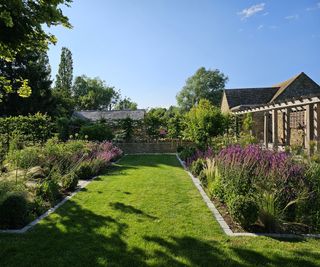
Garden designer Emily Crowley-Wroe approaches her projects first by reading the materials/style of the house and the vernacular of the surrounding area. In her recent 2024 SGD award-winning project the inside of the house had lime-washed walls and contemporary greys and whites.
"This created a light, modern and airy feel while the floor-to-ceiling glass extension draws the outside in," says Emily.
"The blue-grey cobbles and limestone floor reflect these interior materials and complement the purple/blue tones in the planting. Cotswold stone was used for the walling to match the buildings and rusty steel for an agricultural feel," she says.

A professionally trained garden designer based in the Cotswolds, Emily won an award in the prestigious 2024 Society of Garden Design awards.
2. Let planting take centre stage in your landscaping
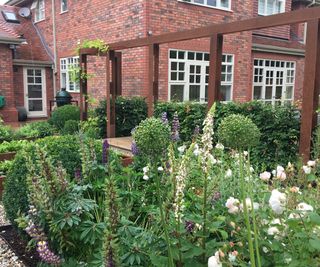
"Without plants, you might as well sit in your living room and have the window open. Immersing yourself in a space filled with plants and the wildlife they attract is one of the simplest but greatest joys in the world," says garden designer Matt Nichol.
"Pave or gravel a space and you can sit in it. I’d argue you’re not going to want to sit there for long though. It’s the planting that makes a garden, everything else simply facilitates humans being in that space for longer, doing the things they want to do. It’s the latter that often gets the attention, but it’s the former that is the vital element," explains Matt.
Adding some patio planting to your landscaping scheme can instantly soften the effect of lots of paving or decking, helping to create a more welcoming outdoor space.

Matt enjoys working with his clients to create imaginative and practical gardens. His thoughtful approach to design considers location and lifestyle in balance to achieve gardens which are sympathetic to their surroundings and client's needs.
3. Make environmental considerations for a healthy garden landscape
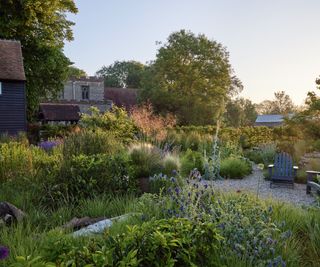
"Integrating elements for habitat creation, such as log piles, gabions, sand piles, and water features, are essential to support local wildlife and create a balanced ecosystem within the garden," says landscape architect Stefano Marinaz.
"These features provide shelter, nesting sites, and food sources for various creatures, contributing to the overall health and resilience of the landscape," says Stefano.
"Incorporating as many permeable surfaces as possible is vital to promote rainwater infiltration, reduce runoff, and mitigate flooding while replenishing groundwater reserves."
"Overall, by including these landscaping elements, a garden can not only be aesthetically pleasing but also environmentally responsible and supportive of local biodiversity," says Stefano.
Our guide on how to make a garden more eco friendly has lots more suggestions for boosting the eco credentials of your plot.

Stefano set up his own company, Marinaz Landscape Architecture, ten years ago, inspired by the vision of giving as many people as possible the opportunity to have a beautifully designed garden. His company offers design, landscaping and installation services and has completed projects all over Britain, Italy and the Netherlands.
4. Keep landscaping materials complementary
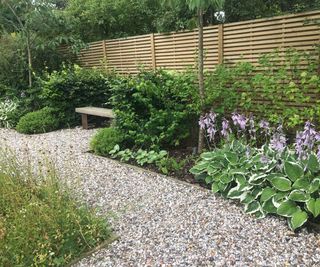
Choosing the materials for your garden landscaping is one of the biggest decisions you'll make in your project, so it pays to carefully consider this part of the process.
What's more, whether you're choosing patio or decking, these hard landscaping materials will take up a large percentage of your overall costs, so think about how they will work together in the finished space to avoid making any costly mistakes.
"There is no optimal number of different materials to combine in a design, this is largely down to the overall design aesthetic and the designer’s/client's preferences. I often use the same material in a number of different formats to create an interesting but, subtle spatial arrangement or detail," explains Matt Nichol.
"Too many materials poorly combined will create a design that lacks unity and this should be avoided. Providing contrast and ‘zig-zag’ in a design layout is where designers can create interest within the design. This has to then be paired with the practicality of the material for any given location and aspect. Remember, not all materials perform well in all conditions," he says.
5. Consider using a garden designer
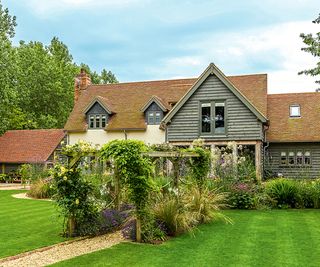
Starting with a bare plot might be your idea of a dream – or it may well feel more daunting than exciting.
It can be hard to know where to start when faced with a completely blank canvas, which is where a garden designer can be worth their weight in gold.
The Society of Garden Designers has a search tool on their website where you can find landscape designers who work in your area.
As when finding an architect or designer for your home, take a look at your previous projects to get an idea of the sort of style and size of gardens they have designed before. It's also worth asking if you can speak to past clients or visit some of their previous projects to see their work in person.
6. Keep your plant choices local
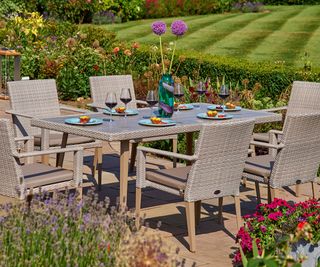
There are several reasons why it is best to choose native plants over non-native. First, they are likely to do far better in the climate they were originally from with less hands-on input, and second, they will usually be cheaper to buy.
As well as choosing indigenous plants, do consider the orientation of your garden as well as your soil type – picking a planting scheme that enjoys free-draining soil and full sun for a shady garden with heavy clay soil is never going to give you an easy ride.
7. Create private spots within your garden landscape
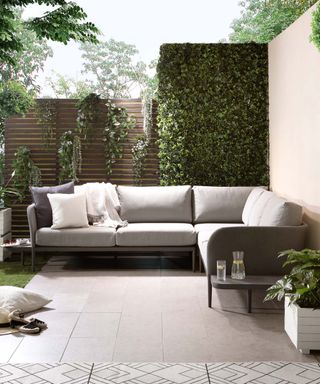
Sheltered and intimate seating spots are important in any garden, but when starting from scratch they can be lacking.
Take a look at the areas of the garden that will make the best dining or relaxing spaces and then ensure they are hidden from prying eyes. For this you need to pull together some ideas for garden fencing, look at building garden walls or planting hedges, or use a combination of these boundary types.
Make sure that your privacy fence ideas won't block too much light or a great view as otherwise you will compromise on your overall enjoyment of the space.
8. Consider your site when planning landscaping
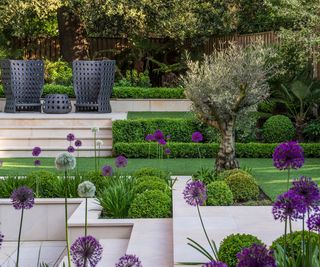
Not all gardens are level, easy-to-work with spaces, but sometimes the most challenging sites result in the most stunning of schemes.
If you don't want to level your garden, rather than working against your site, use what you have. Incorporating terraces is the perfect approach for anyone searching for the most effective sloping garden ideas – plus it helps you instantly form zones within an open space.
9. Create a spot for alfresco dining
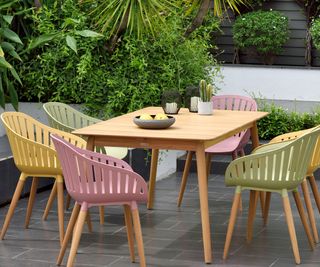
Every garden should have somewhere to sit out and enjoy a meal in the warmer months. Creating a paved spot to locate your outdoor dining furniture will really ensure you can make the most of the new space.
Your chosen patio idea should take into consideration the size of your garden as a whole, where the sun is at the times you are likely to want to sit there the most, and how many people you will want to seat at your garden table.
Think about the paving material you use too – it needs to be level and offer good drainage.
10. Consider building a garden room
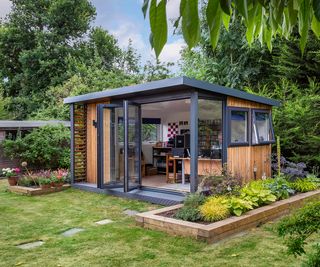
Now is the time to think about whether your garden can play host to a garden room or summer house – it makes sense to construct this at the same time as other landscaping work is underway as you will be able to run power and possibly water and drainage to the space without disrupting the garden at a later date.
Your garden room ideas need to reflect both the style of your house, as well as the size and style of your garden – a contemporary garden will really suit a minimalist design of garden room, while a pretty English country garden will look best paired with a wooden, timber frame or brick built structure.
11. Think through maintenance requirements
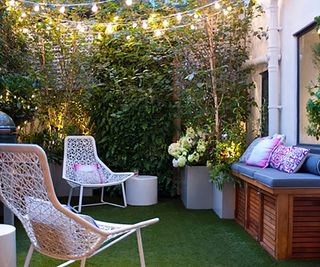
Not everyone relishes the idea of spending their spare time pottering around the garden – in fact for many people gardening can seem more like a chore than a pleasure.
If this sounds like you then really think through your material choices when it comes to your garden – what you are after are low maintenance garden ideas that allow you to enjoy your garden in a hands-off way.
A gravel garden with low-maintenance planting could be a smart solution, while paving, fences and walls (as opposed to hedges) are all features to consider.
This contemporary courtyard garden idea by Kate Gould Gardens was designed to be an easy-to-care for space for children to play and the owners to entertain guests.
12. Get on trend with an outdoor kitchen
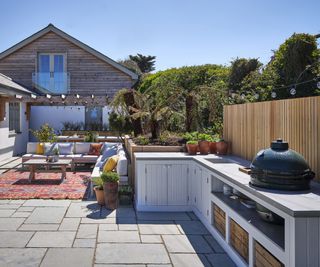
According to a recent report by Atlas Ceramics, outdoor kitchens are one of the most in-demand kitchen trends.
It isn't hard to see the allure of outdoor kitchen ideas – no more lugging meals to and fro and somewhere to store all your barbecue and cooking equipment close to hand. Outdoor kitchens can also be designed to provide shelter (perfect for the unpredictable UK climate).
Creating a new garden from scratch is the ideal time to build an alfresco kitchen too – you will need power for appliances and lighting, and ideally a water supply.
13. Split your garden landscaping into zones
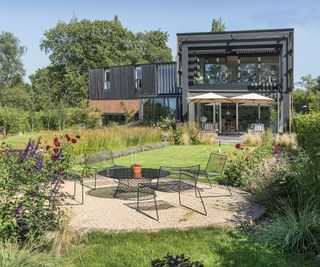
Gardens of all sizes can benefit from being split into different areas. Although zoning is often popular with those after small garden design ideas, this is a great way of dividing up large gardens too in order to avoid them feeling too exposed or lacking in interest.
The zones you create will obviously reflect how you plan on using the space, but possibilities include spaces for dining, quietly relaxing and for children to play in. Hedges, fences, walls and even larger plants can all be used to create different areas.
14. Mix and match hard landscaping materials
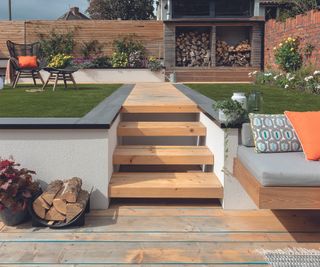
An expanse of hard landscaping can sometimes feel a little soulless but this can be avoided by using a combination of different paving materials.
Some of the best garden paving ideas include natural stone, gravel, porcelain and bricks – combining several of these in various patterns and designs will really add interest and soften the whole look of a space.
15. Introduce water to your garden landscaping
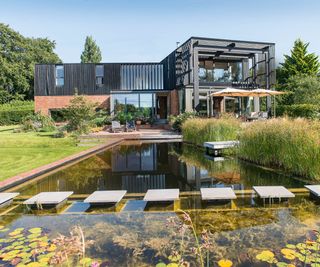
The sight and sound of water in the garden really injects a sense of tranquility and magic into the space. There are so many ways to bring water into your garden design, from small wall-mounted water features to wildlife ponds, grand freestanding fountains or that favourite Japanese garden idea, a koi pond.
It is wise to plan water features in early on in the design process as you might need an electricity source to power pumps and lighting.
Likewise, ponds will benefit from early planning – all the better if you can get them dug while you still have builders on site with the necessary equipment.
16. Incorporate an outdoor fireplace
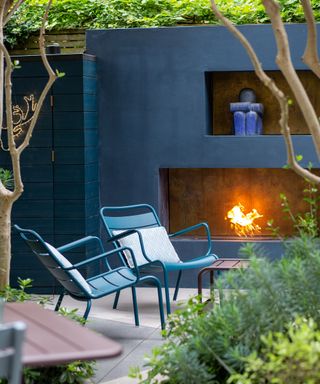
One up from a fire pit or patio heater, outdoor fireplaces not only look great, but they also mean those cosy evenings sitting outside need not be cut short by a sharp drop in temperature.
Locate your new outdoor fireplace close to your seating space and consider whether you will be prepared to use a builder to build the fireplace to ensure it has a good draw.
17. Seize the chance to build a swimming pool
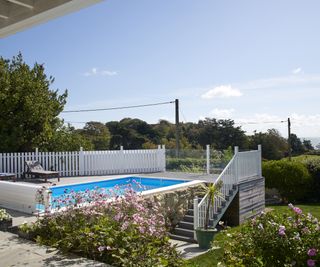
Always dreamt of waking up and diving into your very own swimming pool? Creating a garden from scratch is the ideal time to turn that dream into reality.
Although swimming pools are costly and won't be an option for everyone, they are a highly desirable garden feature for many. The standard size of a swimming pool is 11 x 4m but if your garden is not big enough to accommodate this it is, of course, possible to go smaller – or why not take a look a natural swimming pool instead?
18. Make built-in seating a key element of your garden
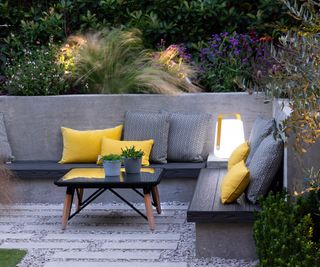
A really popular garden landscaping idea is to create built-in bench-style seating and combine it with planters. This is actually a brilliant idea for those with smaller spaces as it ticks two boxes at once – plus it is a project within the capabilities of most DIYers.
Ensure the new seating space feels protected by using boundaries that are high enough to deal with any potential overlooking issues.
Within this scheme by Kate Gould Gardens the outdoor entertaining space features a large built-in seating area, made up of polished concrete and grey tones with flashes of colour introduced by the soft furnishings and surrounding greenery.
19. Use sunken spaces for a sociable vibe
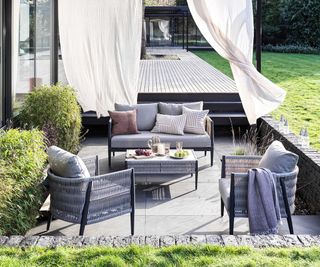
Sunken garden ideas can deal with a number of landscaping issues, including sloping sites and overlooking. However, digging out a sunken patio area is also just a brilliant way to add interest or create a cosy spot in which to gather with friends.
You should look at some retaining wall ideas first as you will need a way to hold the soil back around your new patio. These walls can often be turned into a beautiful garden feature in their own right providing you choose attractive materials to complement those used elsewhere in your garden or house design scheme.
FAQs
How do you landscape a low maintenance garden?
"Try incorporating gravel or paving stones into your garden design, these options require far less maintenance than a grass lawn and will leave your garden feeling effortless yet sophisticated," says garden landscaping expert Tom Clifford, from Gardenstone.
"Remember, before laying down gravel or paving stones it is important to get rid of weeds. When weeds are left untreated they can poke through the surface of your gravel and leave your garden looking unkempt," says Tom.
"When incorporating plants and flowers throughout your garden choose hardy varieties that require little upkeep. Geraniums are low-maintenance flowers that bring interest without the need for constant care," he says
"If you're looking for a low-maintenance shrub to fill up space within your garden, Hebe is the ideal shrub that requires little care and will survive throughout the winter months," suggests Tom.
What is the average cost of landscaping a garden in the UK?
"For professional garden landscaping you can expect to pay a minimum of £5,000 for a basic design," says garden landscaping expert Tom Clifford, from Gardenstone.
"However, if you're looking for a more complex design it may cost anywhere between £10,000 to £20,000, it all depends on the size and scale of your garden and the extent of the transformation you're looking for," says Tom.
How do you landscape a garden for beginners?
"When landscaping your garden it is important not to dive straight in, landscape gardening is all about planning, especially if you lack experience, rushing the process will only lead to more mistakes," says garden landscaping expert Tom Clifford, from Gardenstone.
"I recommend starting by making a list of the features you would like to include in your garden or the areas you plan to change or enhance. Make sure to consider factors like location and sunlight as this can be detrimental to your design," he says.
"For example, if you are looking to incorporate a patio seating area it is a good idea to choose a position that attracts the most sunlight at specific points during the day, if you plan to use this space in the evening you will want to position it in an area with the most sunlight at this time."
Landscaping a garden can have environmental implications, depending on the materials you decide to use for your space.
Opting for local materials and native plants are one of the main ways you can reduce your impact on the environment, but there are also plenty more organic gardening methods you can try to follow when landscaping your plot.
Get the Homebuilding & Renovating Newsletter
Bring your dream home to life with expert advice, how to guides and design inspiration. Sign up for our newsletter and get two free tickets to a Homebuilding & Renovating Show near you.

Teresa was part of a team that launched Easy Gardens in 2018 and worked as the Editor on this magazine. She has extensive experience writing and editing content on gardens and landscaping on brands such as Homes & Gardens, Country Homes & Interiors and Living Etc magazine. She has developed close working relationships with top landscape architects and leading industry experts, and has been exposed to an array of rich content and expertise.
In 2020 Teresa bought her first home. She and her partner worked alongside architects and builders to transform the downstairs area of her two bedroom Victorian house in north London into a usable space for her family. Along the way she learned the stresses, woes and joys of home renovation, and is now looking to her next project, landscaping the back garden.